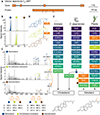De novo phytosterol synthesis in animals
- PMID: 37141360
- PMCID: PMC11139496
- DOI: 10.1126/science.add7830
De novo phytosterol synthesis in animals
Abstract
Sterols are vital for nearly all eukaryotes. Their distribution differs in plants and animals, with phytosterols commonly found in plants whereas most animals are dominated by cholesterol. We show that sitosterol, a common sterol of plants, is the most abundant sterol in gutless marine annelids. Using multiomics, metabolite imaging, heterologous gene expression, and enzyme assays, we show that these animals synthesize sitosterol de novo using a noncanonical C-24 sterol methyltransferase (C24-SMT). This enzyme is essential for sitosterol synthesis in plants, but not known from most bilaterian animals. Our phylogenetic analyses revealed that C24-SMTs are present in representatives of at least five animal phyla, indicating that the synthesis of sterols common to plants is more widespread in animals than currently known.
Figures



References
-
- Lagarda MJ, García-Llatas G, Farré R, Analysis of phytosterols in foods. J. Pharm. Biomed. Anal 41, 1486–1496 (2006). - PubMed
-
- Volkman JK, Sterols and other triterpenoids: source specificity and evolution of biosynthetic pathways. Org. Geochem 36, 139–159 (2005).
MeSH terms
Substances
Grants and funding
LinkOut - more resources
Full Text Sources
Medical

